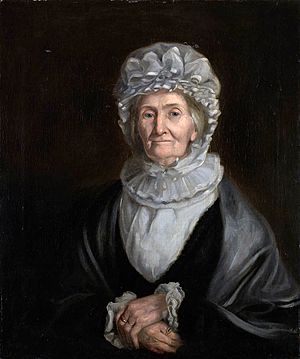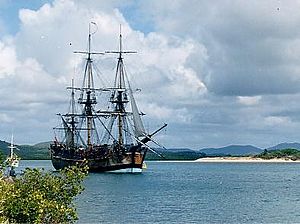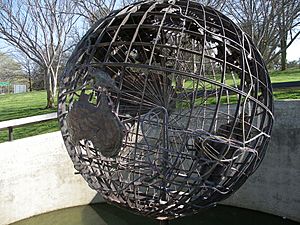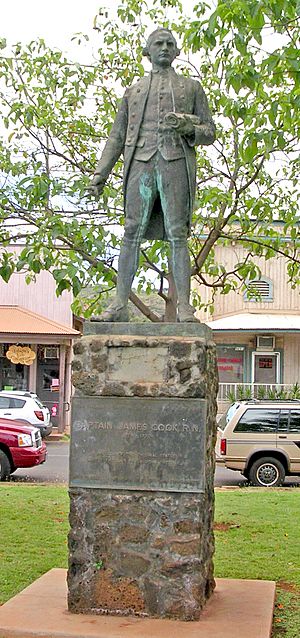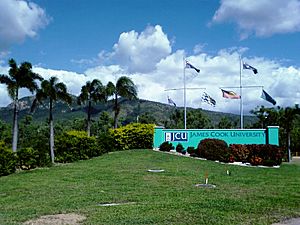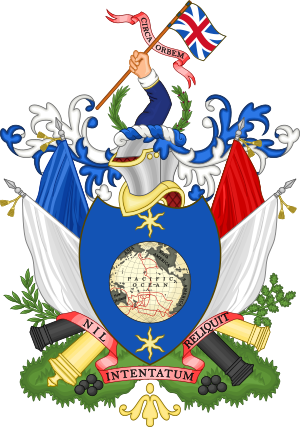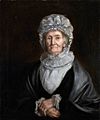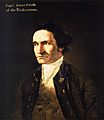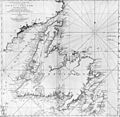James Cook facts for kids
Quick facts for kids
Captain James Cook
|
|
|---|---|

|
|
| Born | 7 November [O.S. 27 October] 1728 Marton, Yorkshire, England
|
| Died | 14 February 1779 (aged 50) |
| Nationality | British |
| Education | Postgate School, Great Ayton |
| Occupation | Explorer, navigator, cartographer |
| Title | Captain |
| Spouse(s) | Elizabeth Batts |
| Children | 6 |
| Parent(s) | James Cook Grace Pace |
| Signature | |
 |
|
Captain James Cook, FRS (27 October 1728 – 14 February 1779) was an English explorer, navigator and cartographer. He made three voyages to the Pacific Ocean, mapping many areas and recording several islands and coastlines on European maps for the first time. He is most notable for the British finding the east coast of Australia, finding the Hawaiian Islands and the first mapping of Newfoundland and New Zealand.
During his lifetime, he sailed twice around the world. He crossed the Antarctic Circle and found new islands and landscapes in North America and the South Pacific. During his trips, he spent a lot of time on science experiments, and mapping new areas. He also wrote a lot of books about what he found.
Contents
Early life
James Cook was born on 7 November 1728 (NS) in the village of Marton in the North Riding of Yorkshire. He was the second of eight children of James Cook (1693–1779), a Scottish farm labourer from Ednam in Roxburghshire, and his locally born wife, Grace Pace (1702–1765), from Thornaby-on-Tees.
In 1736, his family moved to Airey Holme farm at Great Ayton. His father's employer, Thomas Skottowe, paid for Cook to attend the local school. In 1741, after five years' schooling, he began work for his father, who had been promoted to farm manager.
Apprenticeship
In 1745, when he was 16, Cook moved 20 miles (32 km) to the fishing village of Staithes. He became as a shop boy to grocer and haberdasher William Sanderson. Historians have speculated that this is where Cook first felt the lure of the sea while gazing out of the shop window.
After 18 months, Cook understood that he was not suited for shop work. He travelled to the nearby port town of Whitby to meet Sanderson's friends John and Henry Walker. The Walkers, who were Quakers, were prominent local ship-owners in the coal trade. Their house is now the Captain Cook Memorial Museum. Cook was taken on as a merchant navy apprentice in their small fleet of vessels, plying coal along the English coast. His first assignment was aboard the collier Freelove, and he spent several years on this and various other coasters, sailing between the Tyne and London. As part of his apprenticeship, Cook studied of algebra, geometry, trigonometry, navigation and astronomy – all skills he would need one day to command his own ship.
When his three-year apprenticeship was completed, Cook began to work on trading ships in the Baltic Sea. He passes his exams in 1752 and soon progressed through the merchant navy ranks. In 1755, he volunteered for service in the Royal Navy, when Britain was re-arming for what was to become the Seven Years' War.
When serving in the Royal Navy, Cook showed a talent for surveying and cartography and was responsible for mapping much of the entrance to the Saint Lawrence River. His surveying skills were put to good use in the 1760s mapping the jagged coast of Newfoundland, which brought him to the attention of the Royal Society.
Voyages of exploration
On 25 May 1768, the Admiralty commissioned Cook to command a scientific voyage to the Pacific Ocean. Cook, at age 39, was promoted to lieutenant to grant him sufficient status to take the command. The Royal Society agreed that Cook would receive a one hundred guinea gratuity in addition to his Naval pay.
His goals on these missions were:
- to find the Southern continent (terra australis incognita)
- to make astronomical measures of Venus
- to map new lands
- to take over the land for the British King George III
- to watch for good places for new military bases
- to find new routes between the Pacific and the Atlantic.
First voyage (1768–71)
In 1766 the Society hired him to travel to the Pacific Ocean to observe and record a transit of Venus across the Sun. Leaving in 1768, he arrived on April 13, 1769 in Tahiti where he built a small fort and observatory to observe the transit; however, due to the lack of precise scientific instruments, there was no way to accurately measure it.
He then explored the South Pacific for the mythical continent of Terra Australis, with the help a Tahitian named Tupaia who had extensive knowledge of Pacific geography. The Royal Society, and especially Alexander Dalrymple, insisted Terra Australis must exist, despite Cook's personal doubts. He also reached New Zealand, which until then had been visited by Europeans only once, by Abel Tasman in 1642. Cook mapped its complete coastline, discovering Cook Strait which separates the North Island from the South Island. Next, he went on to Australia, where he discovered its east coast.
The site of Cook's first landing, at Kurnell on Botany Bay, was intended to be the site of the first British colony in Australia, but when Captain Arthur Phillip arrived with the First Fleet in 1788, he felt that Botany Bay was unsuitable, and sailed a short distance northwards to Port Jackson, for the establishment of Sydney.
However, Botany Bay was the site of one of the earliest European contacts with Australian Aborigines and the first European sightings of Australian flora and fauna (the name Botany Bay was chosen to reflect the diverse range of flora found there).
Cook also discovered the Great Barrier Reef, when his ship ran aground June 11th 1770; Endeavour was seriously damaged and his voyage was delayed for two months while repairs were carried out. He then sailed through Torres Strait between Australia and New Guinea, again becoming only the second European to do so (the first being Luis Vaez de Torres, in 1604). His ship on this voyage, HM Bark Endeavour, gave the name to the Space Shuttle Endeavour.
By this point in the voyage Cook had lost no men to scurvy, a remarkable and unheard-of achievement in the 18th century. He forced his men to eat such foods as citrus fruits and sauerkraut. Unfortunately, he sailed for Batavia, the capital of the Dutch East Indies, to put in for repairs. Batavia was known for its outbreaks of malaria, and much of Cook's crew would succumb to the disease before they returned home in 1771. Cook's journals were published upon his return and he became something of a hero among the scientific community.
Second voyage (1772–75)
Cook was once again commissioned by the Royal Society to search for the mythical Terra Australis. Despite Cook's evidence to the contrary from the first voyage, Alexander Dalrymple refused to believe a massive southern continent did not exist. Cook commanded HMS Resolution on this voyage, while Tobias Furneaux commanded HMS Adventure.
Cook circumnavigated the globe at a very high southern latitude, becoming the first European to cross the Antarctic Circle on January 17, 1773. In the Antarctic fog, Cook and Furneaux were separated. Furneaux made his way to New Zealand and eventually sailed back to Britain while Cook was still exploring the Antarctic.
On his return voyage, he landed at the Friendly Islands and Easter Island, and returned home having destroyed the myth of Terra Australis.
Another accomplishment of the second voyage was the successful testing of John Harrison's timekeeping instruments, which at last facilitated accurate measurement of longitude.
Upon his return, he was given an honorary retirement from the Royal Navy, but he could not be kept away from the sea. A third voyage was planned to find the Northwest Passage. Cook would travel to the Pacific and hopefully travel east to the Atlantic, while a simultaneous voyage would travel the opposite way.
Third voyage (1776–79)
On his last voyage, Cook once again commanded HMS Resolution, while Captain Charles Clerke commanded HMS Discovery. Cook travelled north and in 1778 became the first European to visit the Hawaiian Islands, which he named the "Sandwich Islands" after the 4th Earl of Sandwich, the then First Lord of the Admiralty. From there, he travelled east to explore the west coast of North America, eventually landing at Nootka Sound on Vancouver Island. He explored and mapped the coast from California all the way to the Bering Strait, discovering what came to be known as Cook Inlet in Alaska on the way.
Personal life
Cook married Elizabeth Batts, the daughter of Samuel Batts, keeper of the Bell Inn in Wapping and one of his mentors, on 21 December 1762 at St Margaret's Church, Barking, Essex. The couple had six children: James (1763–1794), Nathaniel (1764–1780, lost aboard HMS Thunderer which foundered with all hands in a hurricane in the West Indies), Elizabeth (1767–1771), Joseph (1768–1768), George (1772–1772) and Hugh (1776–1793, who died of scarlet fever while a student at Christ's College, Cambridge). When not at sea, Cook lived in the East End of London. He attended St Paul's Church, Shadwell, where his son James was baptised.
Death
Cook attempted to resume his exploration of the Northern Pacific. Shortly after leaving Hawaii Island, however, the Resolution's foremast broke, so the ships returned to Kealakekua Bay for repairs. Tensions rose, and a number of quarrels broke out between the Europeans and Hawaiians at Kealakekua Bay.
An unknown group of Hawaiians took one of Cook's small boats. Cook was forced into a wild goose chase that ended with his return to the ship frustrated. He attempted to kidnap and ransom the King of Hawaiʻi, Kalaniʻōpuʻu.
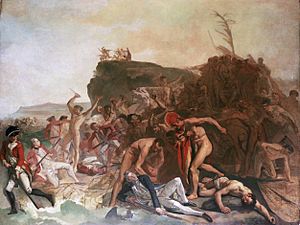
That following day, 14 February 1779, Cook marched through the village to retrieve the King. Cook took the King by his own hand and led him willingly away. The king began to understand that Cook was his enemy. As Cook turned his back to help launch the boats, he was struck by the villagers which resulted in his death. The Hawaiians carried his body away towards the back of the town, still visible to the ship through their spyglass. Four marines, Corporal James Thomas, Private Theophilus Hinks, Private Thomas Fatchett and Private John Allen, were also killed and two others were wounded in the confrontation.
Legacy
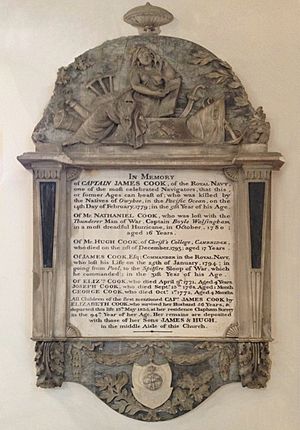
The Australian Museum acquired its Cook Collection in 1894 from the Government of New South Wales. At that time the collection consisted of 115 artefacts collected on Cook's three voyages throughout the Pacific Ocean, during the period 1768–80, along with documents and memorabilia related to these voyages. The collection remained with the Colonial Secretary of NSW until 1894, when it was transferred to the Australian Museum.
Cook's 12 years sailing around the Pacific Ocean contributed much to European knowledge of the area. Several islands such as the Sandwich Islands (Hawaii) were encountered for the first time by Europeans, and his more accurate navigational charting of large areas of the Pacific was a major achievement.
Cook carried several scientists on his voyages; they made significant observations and discoveries. Two botanists, Joseph Banks and Swede Daniel Solander, were on the first voyage. The two collected over 3,000 plant species. Banks subsequently strongly promoted British settlement of Australia.
Artists also sailed on Cook's first voyage. Sydney Parkinson was heavily involved in documenting the botanists' findings, completing 264 drawings. They were of immense scientific value to British botanists. Cook's second expedition included William Hodges, who produced notable landscape paintings of Tahiti, Easter Island, and other locations.
Cook's contributions to knowledge were internationally recognised during his lifetime. In 1779, while the American colonies were fighting Britain for their independence, Benjamin Franklin wrote to captains of colonial warships at sea, recommending that if they came into contact with Cook's vessel, they were to "not consider her an enemy, nor suffer any plunder to be made of the effects contained in her, nor obstruct her immediate return to England by detaining her or sending her into any other part of Europe or to America; but that you treat the said Captain Cook and his people with all civility and kindness, ... as common friends to mankind." Unknown to Franklin, Cook had met his death a month before this safe conduct "passport" was written.
Cook's voyages were involved in another unusual first. The first recorded circumnavigation of the world by an animal was by Cook's goat, who made that memorable journey twice. When they returned to England, she was put to pasture on Cook's farm outside London. Cook's journal recorded the date of the goat's death: 28 March 1772.
A US coin, the 1928 Hawaiian half dollar carries Cook's image. Minted for the 150th anniversary of his discovery of the islands, its low mintage (10,008) has made this example of Early United States commemorative coins both scarce and expensive.
The site where he was killed in Hawaii was marked in 1874 by a white obelisk set on 25 square feet (2.3 m2) of chained-off beach. This land, although in Hawaii, was deeded to the United Kingdom. A nearby town is named Captain Cook, Hawaii; several Hawaiian businesses also carry his name.
The first institution of higher education in North Queensland, Australia was named after him, with James Cook University opening in Townsville in 1970. Numerous institutions, landmarks and place names reflect the importance of Cook's contributions, including the Cook Islands, the Cook Strait, Cook Inlet, and the Cook crater on the Moon. Aoraki/Mount Cook, the highest summit in New Zealand, is named for him.
Another Mount Cook is on the border between the US state of Alaska and the Canadian Yukon Territory, and is designated Boundary Peak 182 as one of the official Boundary Peaks of the Hay–Herbert Treaty. A life-size statue of Cook upon a column stands in a park in the centre of Sydney.
Interesting facts about James Cook
- As a child, Cook enjoyed the opportunity for solitude and would climb a nearby hill, Roseberry Topping for leisure.
- Cooks' Cottage, his parents' last home, is now in Melbourne, Australia. It was moved from England and reassembled, brick by brick, in 1934.
- Cook almost discovered the mainland of Antarctica, but turned back north towards Tahiti to resupply his ship.
- Cook has no direct descendants – all of his children died before having children of their own.
- The Australian slang phrase "Have a Captain Cook" means to have a look or conduct a brief inspection.
- The Apollo 15 Command/Service Module Endeavour was named after Cook's ship, HMS Endeavour, as was the space shuttle Space Shuttle Endeavour. Another shuttle, Discovery, was named after Cook's HMS Discovery.
Arms
Images for kids
-
Portrait of James Cook by William Hodges, who accompanied Cook on his second voyage
-
James Cook's 1777 South-Up map of South Georgia, which he named after King George III
-
Hawaiian ʻahuʻula (feather cloak) held by the Australian Museum
-
A 1775 chart of Newfoundland, made from James Cook's Seven Years' War surveyings
-
William Hodges' painting of HMS Resolution and HMS Adventure in Matavai Bay, Tahiti
See also
 In Spanish: James Cook para niños
In Spanish: James Cook para niños


